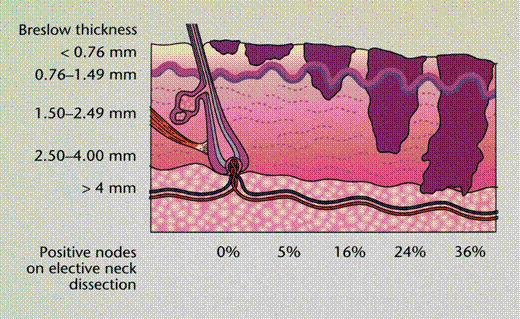Defined by Breslow in 1970, it refers to the thickness of the excised melanoma. An ocular micrometer is used to measure it.

For the assessment of the Breslow Index, pathological examination of melanoma is done on a section of tissue stained with a histological staining method called H&E (hematoxylin and eosin) stain. This allows the pathologist to accurately measure the depth of the melanoma.
This index has played and continues to play a fundamental role in the classification and staging of melanoma. Measurement of tumor thickness provides an estimate of disease severity and tumor aggressiveness. Generally, the higher the Breslow index, the more likely it is that cancerous cells have spread to other parts of the body.
Each level of the Breslow index provides an estimate of 5-year survival for patients with melanoma. Here are the details:
- Level I: Less than 1 mm, with a 5-year survival of between 95% and 100%. This group has the best prognosis as the tumor is very superficial and the chances of metastasis are very low.
- Level II: Between 1 and 2 mm, with a 5-year survival of between 80% and 96%. At this stage, the melanoma has begun to grow deep, but is still very small.
- Level III: Between 2.1 and 4 mm, with a 5-year survival of between 60% and 75%. At this level, the melanoma is deeper and the chances of metastasis are increased.
- Level IV: Greater than 4 mm, with a 5-year survival of between 37% and 50%. This is the most severe level, where the melanoma is very deep and the risk of metastasis is very high.
Furthermore, the Breslow Index is often used in conjunction with other clinical and pathological characteristics to determine the most appropriate treatment for melanoma. It is important to note that these numbers are estimates only, and the prognosis may vary based on various factors, including the patient’s overall health, response to treatment, and other pathological parameters of the tumor.